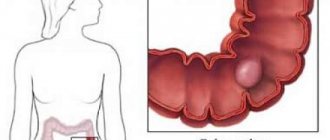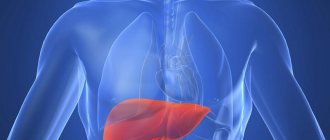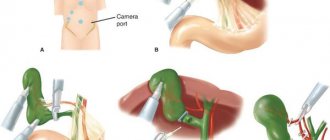The article was checked by a gastroenterologist, endoscopist Kondrashova E.A., is for general informational purposes only and does not replace specialist advice. For recommendations on diagnosis and treatment, consultation with a doctor is necessary.
Specialists from the Department of Gastroenterology and Hepatology of the Yauza Clinical Hospital successfully diagnose drug-induced and toxic liver damage and prescribe optimal treatment to restore liver function. The patient is asked to undergo a comprehensive examination, including laboratory tests (general and biochemical blood tests, as well as a package of tests that exclude other liver pathologies) and instrumental tests (ultrasound of the abdominal organs, FGDS, if indicated - CT and MRI, fibroelastography). Based on the results of the examination, a diagnosis is made and therapy is selected aimed at restoring liver function.
Types of liver damage
Based on the reasons that led to pathological changes in the liver tissue, several types of lesions of this organ are distinguished:
- toxic;
- medicinal;
- immune;
- infectious;
- dystrophic;
- oncological;
- metabolic
Of all the above types, drug-induced and toxic liver damage is the most common. Drug-induced damage develops due to long-term use of certain types of medications. Children under three years of age and people over forty are at increased risk.
As for toxic damage, it is provoked by exposure to toxic substances on the body, the main of which is alcohol and its breakdown products. According to recent data, about a third of people suffering from alcoholism have some kind of liver problems.
What liver functions ensure a woman’s health?
The importance of normal liver function is the same for people of both sexes. This organ synthesizes a lot of necessary substances, is the largest depot of energy reserves, and utilizes biochemical processing methods toxins, poisons, and all waste products that the body receives from the external environment and produces during life.
It is impossible to replace the functions of the liver with another organ. A significant reserve supply of cells allows the work to be performed even with the loss of 1/3 of the parenchyma. Therefore, a person does not immediately detect the first signs of the disease.
The liver is involved in and controls all types of metabolism
In protein metabolism - synthesizes essential amino acids, various types of protein components for building cell membranes, performing transport functions, immunoglobulins, blood clotting and anti-clotting factors. In fat metabolism - produces lipoproteins, cholesterol, triglycerides.
Carbohydrate metabolism is ensured by obtaining energy from incoming glucose and glycogen reserves. In the liver, if necessary, reactions can occur to “extract” calories from proteins and fats. To carry out such a synthesis, enzymes and coenzymes are needed. Their role is played by vitamins B, PP, C, K, E, D, and reserves of microelements cobalt, iron, and copper.
The liver is connected to other organs through the endocrine system. For the female body, its role as a producer of sex hormones, ensuring the functioning of the adrenal glands and thyroid gland is extremely important.
A “factory” for processing waste and toxins with a healthy liver does not allow the accumulation of products remaining after the absorption of food, medicines, alcohol, industrial and household harmful substances. They are disinfected and released into the intestines with bile. At the same time, the liver maintains the necessary composition and process of bile formation for digestion.
The load increases significantly during pregnancy. During this period, the woman’s liver ensures hematopoiesis of the fetus and cleanses the blood of the mother’s body.
Impaired metabolism in the liver leads to diseases of other organs
Causes of liver damage
Among the most common causes of liver damage are:
- long-term alcohol abuse;
- drug use;
- poisoning with salts of heavy metals (mercury, copper, zinc and others);
- intoxication with various poisons (aldehydes and phenols, chloroform and benzene derivatives, arsenic and copper sulfate and others);
- consumption of products that contain aflatoxin (“stale” wheat, rice, soybeans, spoiled corn and peanuts, dishes made from them);
- poisoning with poisonous mushrooms;
- long-term or one-time use in large doses of certain medications (psychotropic, anticonvulsant, antibacterial drugs and hormonal contraceptives, non-steroidal anti-inflammatory drugs, calcium blockers, anti-tuberculosis and antifungal drugs, cytostatics and others).
All of these are risk factors and, under negative circumstances, can lead to serious disruptions in the functioning of the main filtering organ, which can lead to the development of liver failure, and in the absence of proper treatment, often leads to cirrhosis, disability and even death. Fortunately, if you seek medical help in a timely manner, the patient’s chances of recovery are very high. Our hospital specialists are ready to help patients at any stage of the disease, selecting an individual technique taking into account the characteristics of the course of the disease in a particular patient.
Diabetes
Since the liver is a kind of filter for the blood, it is one of the first to react to elevated blood glucose levels and disturbances in insulin metabolism. In diabetes mellitus, not only the metabolism of carbohydrates (“sugar”) is disrupted, but also the metabolism of fats and proteins. The breakdown of fats occurs chaotically, resulting in a large number of free fatty acids. Inflammatory reactions are triggered, including in the liver. In the initial stages of the disease, timely correction of blood glucose levels and weight control is sufficient for treatment. Patients must constantly follow a diet and take medications to protect liver cells.
Symptoms
There are acute (simultaneous use of a toxic substance) and chronic (a substance containing a toxin enters the body in small quantities, but for quite a long time) toxic and drug-induced liver damage. In the case of chronic poisoning, due to the high ability of the liver to regenerate and its lack of nerve endings, toxic damage to the liver, the symptoms of which will be described below, can proceed latent for a long time, manifesting itself clinically when the liver tissue is already significantly destroyed.
The following symptoms are a reason to be wary and consult a specialist:
- nausea and vomiting;
- bitterness in the mouth;
- weight loss;
- decreased appetite;
- change in color of stool and urine;
- stool disorder;
- constant weakness;
- increasing drowsiness;
- skin itching;
- yellowing of the skin and mucous membranes.
If several symptoms are combined, you should immediately consult a doctor. At the Clinical Hospital on Yauza, you can quickly get an appointment and undergo a full examination in the shortest possible time.
Signs of liver inflammation
Let's look at the most common signs of liver inflammation. A person who exhibits at least some of the following symptoms may be suspected of having hepatitis:
- pain in the right hypochondrium. This is one of the most common symptoms. Inflammation causes the liver to increase in size, which, in turn, promotes stretching of the fibrous membrane of the liver. This is what causes the nagging pain;
- increase in body temperature. This phenomenon is a direct consequence of a pronounced inflammatory process, and occurs mainly in hepatitis of a viral nature;
- itching, rashes and redness of the skin. Inflammation of the liver causes a deterioration in the outflow of bile, as a result of which some of the bile acids enter the blood, causing irritation of the skin;
- digestive disorders. This phenomenon is also associated with a violation of the outflow of bile. The liver takes an active part in the digestive process by producing bile, which is necessary for the breakdown of fats. In patients with hepatitis, eating fatty foods causes diarrhea. However, this unpleasant phenomenon can also occur after eating large amounts of protein, baked goods and sweets. In addition, the patient may experience constipation, belching, loss of appetite, increased gas formation due to fermentation of poorly digested food in the intestines, vomiting, and an unpleasant taste in the mouth;
- tendency to hematomas and bleeding. These symptoms are closely related to inflammatory processes in the liver, since it is in this organ that a significant portion of platelets are formed. As we have already found out, inflammation causes a decrease in the functional abilities of the liver, and since one of these is the production of platelets, any cut can cause severe blood loss due to deterioration of coagulation (platelets are known to be responsible for blood clotting), and the slightest bruise is fraught the appearance of large hematomas;
yellowness of the sclera and skin. Bilirubin is a bile pigment that is formed as a result of hemolysis (breakdown of red blood cells). Bilirubin has a characteristic light brown color, so if it is in excess, it enters the sclera of the eyes and skin along with the bloodstream, changing their color. “All this is wonderful, however, what causes the increase in the content of this pigment in the blood?” - the meticulous reader will ask. The question is quite natural and deserves a detailed answer. An indirect form of bilirubin is formed in tissues, which has toxic properties. Indirect bilirubin is very poorly soluble in water, so it enters the liver along with the bloodstream to be eliminated from the body. It is in the liver that indirect bilirubin is converted into a direct form, which, unlike its prototype, has normal solubility and is excreted from the body along with feces and urine. With liver inflammation, the process of red blood cell death intensifies, which means the amount of bilirubin in the blood also increases. In addition, with an increased level of bilirubin in the blood, stool becomes discolored and urine darkens;- weakness, fatigue, frequent headaches, irritability and poor sleep. All these symptoms are caused by general intoxication of the body, which is accompanied by inflammation of the liver.
Diagnostics at the clinical hospital on Yauza
Diagnosis of liver damage in the clinical hospital on Yauza is aimed primarily at establishing the cause that led to toxic liver poisoning. To do this, a conversation is held with the patient, during which it becomes clear what medications the patient used, in what conditions he works, whether he abuses alcohol, whether he was exposed to any other toxic substances, in what doses the substance entered the body, etc.
To make an accurate diagnosis and select the most appropriate treatment regimen, the patient is sent for examination, which consists of laboratory and instrumental diagnostics.
Laboratory diagnostics include:
- blood chemistry;
- general blood analysis.
A general blood test allows you to assess the condition of the body as a whole, while a biochemical study gives a detailed picture of the functional state of the liver, kidneys, and pancreas, which often also suffer from poisoning. Particular attention is paid here to the level of liver enzymes and their ratio. Total, direct and free bilirubin, aspartate aminotransferase, alanine aminotransferase, cholinesterase, albumin, and prothrombin index are assessed.
Instrumental diagnostics includes:
- Ultrasound of the abdominal organs;
- esophagogastroduodenoscopy.
- CT and MRI;
- fibroelastography;
- according to indications - endosonography.
All studies in our hospital are carried out using modern, highly informative equipment, which allows us to quickly and accurately diagnose liver lesions and determine the stage of the disease.
Hepatotoxic effects of medications
Often the cause of liver destruction is the toxic effect of medications. In some cases, substances contained in medications act as direct cellular toxins. Their action, as a rule, is predictable. Some drugs are toxic only for patients with high sensitivity to the active substance. There is no separate classification for these diseases, but in most cases we can only talk about hemolytic, hepatocellular, cholestatic and mixed reactions.
Establishing the severity of liver damage
According to laboratory studies, the severity of hepatocyte damage and the activity of the process are determined. Here, special attention is paid to the level of enzymes secreted by the body for detoxification. Depending on the excess level of enzymes in the blood, the severity of inflammation is determined (from weakly active to highly active hepatitis). An important point here is also to monitor the increase in signs of liver failure, by which one can judge the acute or chronic nature of the poisoning that caused toxic hepatitis.
What examination does the doctor prescribe?
Patients with even minimal symptoms should carefully approach the problem of examination, take all tests and undergo studies to determine the role and extent of liver damage.
The most common recommended tests: complete blood count, coagulation factors, protein, alanine and aspartic transaminases, bilirubin, glucose.
A urine test checks for the presence of excretion of bilirubin, protein, and glucose. Special tests are prescribed to detect viral hepatitis: viral markers, enzyme-linked immunosorbent assay for antibodies or antigens, immunoblotting, polymerase chain reaction method to detect RNA viruses.
A gynecologist-endocrinologist will advise you to check the hormonal composition of the blood and prescribe an ultrasound of the genital organs, thyroid gland, and adrenal glands.
To check the structure of the liver, size, and circulatory conditions of the organ, the following are used: ultrasound, computed tomography and magnetic resonance imaging. These methods are used to diagnose nodular formations and enlarged lobes. A cytological conclusion is obtained only after examining punctate material or liver tissue biopsy.
To decide on surgical intervention, you may first need to examine the surface of the organ using laparoscopy. Under anesthesia, a probe with an optical device at the end is inserted into the peritoneum through a small incision. It is possible to take samples of material from the damaged area. The diagnosis is made only after comparing all types of studies.
Treatment at the clinical hospital on Yauza
As soon as the patient is given an accurate diagnosis, our specialists immediately prescribe treatment, which is carried out in several stages:
- eliminating the influence of the toxin;
- prescribing a special “liver” diet, the observance of which “spares” the liver
- detoxification of the body and administration of antidotes;
- prescribing drugs to restore liver function.
The first priority, of course, is to eliminate the influence of the substance that caused liver damage. If the reason lies in the use of any medication that the patient cannot do without, the doctor replaces it with another, less toxic drug, or reduces the dose to a minimum. In this case, it may be necessary to work together with hepatologists and specialists from other areas of medicine to select a drug that performs its task, but does not cause drug-induced liver damage, the symptoms of which must be relieved. The capabilities of our hospital allow specialists from different fields to consult with each other and jointly select treatment.
Nutritional features and diet for liver restoration
In the treatment of liver inflammation of any etiology (both chronic and acute viral), diet plays an important role. At least partial compliance with it would help many patients prevent the development of chronic hepatitis.
It is important to remember that diet for liver recovery is very important.
When treating a disease (especially viral forms with pronounced clinical manifestations), the diet must be strictly followed.
Otherwise, the liver will be under stress, making timely recovery impossible. “But untimely things will suit me!” - the patient will exclaim joyfully and go to empty the refrigerator full of fatty foods and alcohol. In this case, prolonged recovery threatens to transform into a chronic form of hepatitis, in which the above symptoms will accompany the patient for the rest of his life.
The basis of the diet for diet No. 5 includes the following products and dishes:
- vegetarian soups cooked in water;
- gray and bran bread;
- lean meat. Regardless of what type of meat (fish, poultry, beef) the patient eats, it should not contain a large amount of fat. Recommended for consumption are beef, lean pork, chicken, turkey, bream, mullet, pike, tuna, flounder, cod, pollock;
- dairy products: low-fat milk and cheese, kefir, cottage cheese. There is no need to worry about the fat content of the latter - in most cases, in cottage cheese it does not exceed 10%, which is at least three times less than the fat content of the lowest-fat cheese;
- boiled eggs, baked omelet, preferably no more than 2 yolks per day;
- It is preferable to use cereals as a side dish: wheat, oatmeal and buckwheat are best suited. At the same time, you should avoid all kinds of instant cereals - they do more harm than good;
- vegetables and fruits in any form - both raw and stewed (when cooking, it is important not to overdo it with adding oil). Sauerkraut is also allowed, with the only caveat that it should not be too sour.
Salted, fried, sour and smoked foods, meat broths, fatty meats and animal fats, baked goods and fresh white bread, sausages, frankfurters and other semi-finished products are contraindicated for consumption. In addition, it is not recommended to consume sweets (especially cream pies and cakes), strong black coffee, and chocolate. You should use radishes, sorrel, garlic and mushrooms with caution. It’s also better to forget about sour cream, fatty cheeses and ice cream.
Separately, I would like to note the need to give up alcoholic beverages. Very often, it is alcohol abuse that provokes the development of inflammatory processes and fatty liver disease.
The problem of alcohol abuse is primarily psychological, so at the very beginning of treatment you need to accustom yourself to the idea that you need to give up this bad habit. Otherwise, hepatitis has every chance of developing into alcoholic cirrhosis. After the condition improves, alcohol should also be treated with extreme caution - its use should not be systematic. Hot girls are waiting for a call by phone numbers published on this site! They will come to your home, hotel, sauna and show you a class in lovemaking! Prostitutes, masters of erotic massage, explicit dancing and light perversions. Do you want to decorate a men's holiday - a bachelor party, a birthday? prostitutes in Yekaterinburg Paid beauties of the city of Yekaterinburg offer their services inexpensively to men and couples for pleasant leisure time. Young girls and mature ladies with rich experience and fiery temperament will delight you with the absence of complexes and restrictions in sex. All the joys of the body, various sexual delights
It is also advisable to refrain from smoking, since the liver is forced to process a number of toxic substances (for example, hydrocyanic acid) that enter the bloodstream along with tobacco smoke.
Advantages of treatment in our hospital
- Doctors. Diagnosis and treatment of liver lesions at the hospital on Yauza are carried out by highly qualified specialists with extensive practical experience in the field of hepatology and gastroenterology.
- Diagnostic accuracy. The latest laboratory and instrumental equipment used in our hospital is highly accurate, which allows us to accurately make diagnoses.
- Individual approach. We take into account the characteristics of each clinical case and patient when selecting diagnostic methods, drug treatment, herbal medicine, diet, etc.
- Efficiency. We value your time and know how important it is to be able to begin treatment without delay, so we try to serve patients as quickly as possible.
- High quality of service provision. The quality of our services fully meets the high requirements of international standards.
- Comprehensive support. By contacting us, patients can count on comprehensive support: our specialists will answer any questions, give recommendations, and, if necessary, provide psychological assistance.
Advantages of NEARMEDIC clinics
The NEARMEDIC network of clinics will provide you with effective assistance because:
- On the staff of any clinic there are certified gastroenterologists of the highest category who will conduct a preliminary examination, prescribe laboratory tests and professional treatment;
- our Diagnostic Center provides laboratory services of guaranteed quality, which is confirmed by the appropriate certificate;
- The Laboratory Diagnostics Center is equipped with the most modern equipment for conducting all types of examinations and analyses;
- We prefer drug treatment, and in severe cases we try to use gentle surgical treatment methods that eliminate complications.
Any data about the patient obtained during the examination and treatment is confidential and is not transferred to other persons.
Gastroenterologists of the highest category have extensive experience in successfully treating acute and chronic forms of liver damage. If symptoms appear, please contact one of the network clinics in a timely manner using the general telephone number +7 (495) 6 171 171 or through the call back form on the website.
Treatment of diseases
Therapy for liver disease should begin early. The organ's resistance to damaging factors gives it a chance to preserve and support the remaining intact tissues.
Women suffering from alcoholism have the opportunity to restore some of the liver cells with the help of intensive therapy and complete abstinence from drinking alcohol. At the same time, a very positive aspect is a change for the better in appearance, the appearance of signs of skin rejuvenation, and the elimination of cosmetic defects.
It is definitely recommended to include physical therapy and long walks in your regimen. If you are overweight, it is necessary to unload and perform feasible physical exercises under medical supervision.
Diet
Liver pathology is accompanied by impaired absorption of food, especially fat. Exacerbation of pain syndrome is often associated with overeating. Therefore, the following should be excluded from the diet of a sick person:
- fatty meat dishes;
- confectionery and sweets;
- legumes;
- hot seasonings and sauces;
- porridge from pearl barley, corn, wheat and barley;
- smoked meats and pickles;
- all types of alcohol, sparkling water, beer;
- strong coffee and tea;
- baking;
- any fried foods.
You should absolutely avoid fast food
It is recommended to exclude radishes, radishes, garlic, onions, white cabbage, sorrel, spinach from the set of vegetables, and cranberries, citrus fruits, currants, raspberries, and grapes from berries and fruits. The following juices are contraindicated: tomato, grape, orange.
To restore the cells of a diseased organ, all substances, vitamins, microelements, and sufficient calorie intake are needed. The following foods are allowed in the diet:
- lean meat (chicken, rabbit, veal);
- vegetable, mucous, milk soups with cereals;
- low-fat kefir, cottage cheese;
- seafood, low-fat fish;
- products made from high-grade wheat (pasta);
- cereals (oatmeal, buckwheat);
- steamed egg white omelette;
- salads with fresh vegetables and herbs, seasoned with vegetable oil;
- fresh fruits, vegetables, compotes, decoctions, juices, fruit drinks.
Drug therapy
Hepatitis is treated with different means depending on the etiology (antiviral drugs, corticosteroids, antibiotics, cytostatics). The class of essential phospholipids includes Essentiale Forte, Phosphogliv, Esliver. Normalize fat metabolism in hepatocytes.
Herbal preparations:
- from milk thistle Gepabene, Silimar, Karsil, Silymarin;
- from chicory and yarrow LIV-52;
- from artichoke Hofitol.
If functional liver disorders are detected in pregnant women, obstetricians recommend, in addition to diet, taking the well-known hepatoprotector Essentiale for a course of 40–60 days.
The class of medicines of animal origin includes drugs made from the liver of pigs and cattle; they are suitable for humans to cleanse the body and relieve intoxication (Sirepar, Hepatosan).
Medicines with amino acid composition contain essential protein components, are strong antioxidants, and restore hepatocytes (Heptral, Heptor). Treatment for parasitic etiology of liver damage is effective only with specific drugs.
The drug belongs to the group of dietary supplements
When do you turn to surgery?
Symptomatic treatment of cirrhosis may require hemostatic agents, urgent surgical intervention for varicose veins of the esophagus and stomach. Removal of a liver abscess or hydatid cyst is carried out under conditions of extreme caution. The entry of the pathogen into the blood causes general sepsis.
In case of hypertension in the portal vein system, operations are performed to create additional blood outflow pathways. In cases of severe liver failure, it is impossible to restore the organ, so the only option is a donor liver transplant.
Traditional medicine tips
In folk medicine, for the chronic course of diseases, after the signs of exacerbation have been removed, decoctions and tinctures of the following medicinal herbs are recommended: dandelion and artichoke roots, rose hips, strawberry leaves, and corn silk. Milk thistle cake (meal) can be purchased at the pharmacy. It is brewed in a thermos or taken before meals, chewed and washed down with water.
For a woman's health, liver dysfunction threatens many problems. Even minor signs cause lasting changes over time. Therefore, examination and treatment cannot be delayed. This is especially true for women hoping to give birth to a healthy child.









